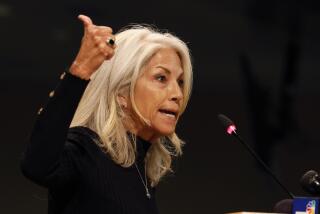Walter S. Graf dies at 98; cardiologist helped launch paramedic system
- Share via
As recently as the 1960s, a patient being rushed to the hospital with crushing chest pain would be treated en route only with sirens and sympathy.
Alarmed by high death rates and encouraged by new technology, a small group of pioneering physicians started equipping ambulances with defibrillators and paramedics who knew how to use them. Although today the idea seems straightforward, it was a radical departure from established protocols and was credited with saving countless lives.
“What it all means is that if you have any regard for your health and are over 40, you ought to move to Los Angeles,” Dr. Walter S. Graf told The Times in 1978. “Your chances for avoiding sudden death are enhanced.”
Graf, a cardiologist who helped establish the modern system of paramedic emergency care, died Oct. 18 at his Los Angeles home, family members said. He was 98.
Graf was former chief of staff for the Daniel Freeman Hospital. In the 1960s, he established what was thought to be the West Coast’s first dedicated coronary care units there and later created the groundbreaking Daniel Freeman Paramedic Training Program. In 1999, it merged with the UCLA Center for Prehospital Care.
In 1969, Graf, who was then president of the Los Angeles chapter of the American Heart Assn., converted a white Chevy van into a “mobile critical care unit.”
The idea was to speed to heart attack calls with a Daniel Freeman nurse and a portable defibrillator. Later, training was expanded to include firefighters and emergency medical technicians — groups that, according to Graf’s studies, performed just as well as nurses at saving cardiac patients.
“It’s easy to take for granted the incredibly elaborate, sophisticated EMS system that we have today, but just 50 years ago, it did not exist,” Dr. Clayton Kazan, the medical director for the Los Angeles County Fire Department, said in a statement. “While ambulance transportation existed, virtually no medical care was provided until the patient arrived at the hospital.”
Graf’s “Heart Car” — named for its Heart Emergency Assistance Response Team — helped spark “a movement that has been responsible for saving innumerable lives worldwide,” Kazan said.
In 2010, Graf and three other physicians were honored by the County of Los Angeles Fire Museum as “pioneers in paramedicine.” The others were J. Michael Criley, Eugene Nagel and Leonard Cobb.
In interviews, Graf said he was inspired by the work of Irish physician Frank Pantridge, who chronicled his success with emergency care in a British medical journal.
“Amazingly, the reaction of the British medical establishment consisted for the most part of disbelief, ridicule and even hostility,” the Guardian, a British newspaper, noted in its 2005 obituary of Pantridge.
“It was to be 16 years before the concept of taking the care to the patient was fully accepted,” the Guardian wrote. “The reaction in America was totally different, and the creation of mobile units was both swift and comprehensive.”
Born in New York City on July 15, 1917, Graf grew up in the Bronx, the son of a jewelry designer for high-end stores like Tiffany & Co. He attended the City College of New York.
When his father wound up unemployed in the Depression, Graf sought work for him in San Francisco, where he hoped to go to medical school. Graf found his father a job, asked a dean at City College for his father’s $50 bus fare, and hoped for the best.
“I put my daddy on the bus and kissed the bus,” he said in an oral history videotaped for his family this year. “A few months later, he sent money for us to join him.”
Graf received his medical degree from UC San Francisco in 1942. He served as an Army physician in Europe and North Africa.
In California, Graf taught medicine at the University of Southern California and Loma Linda University. He had a thriving cardiology practice, and one of his longtime patients was Kenneth Hahn, a former Los Angeles County supervisor.
It was Hahn who pushed Gov. Ronald Reagan to sign a 1970 bill allowing trained personnel other than doctors and nurses to administer emergency care. Graf helped write the bill, which established a pilot program in Los Angeles County.
Facing opposition from doctors, nurses and lawyers, Reagan asked Hahn whether ambulances would be allowed to cross city lines in L.A. County. Then he OKd the measure, recalling that his father, Jack Reagan, had died of a heart attack in 1940 when a Los Angeles ambulance was restricted from crossing into Beverly Hills, where he had been stricken.
Graf’s survivors include his wife, Joan; nine children and stepchildren; 19 grandchildren; and 22 great-grandchildren. He had three previous marriages.
More to Read
Start your day right
Sign up for Essential California for the L.A. Times biggest news, features and recommendations in your inbox six days a week.
You may occasionally receive promotional content from the Los Angeles Times.








